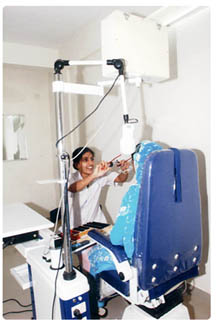Lasik Surgery-Spectacle Removal Surgery in India
LASIK, an acronym for Laser-Assisted in Situ Keratomileusis, is a form of refractive laser eye surgery procedure performed by ophthalmologists intended for correcting myopia, hyperopia, and astigmatism. The procedure is usually a preferred alternative to photorefractive keratectomy, PRK, as it requires less time for full recovery, and the patient experiences less pain overall. Many patients choose LASIK as an alternative to wearing corrective glasses or contact lenses.
What is LASIK?
LASIK (laser in situ keratomileusis) is a laser vision correction technique that uses an excimer laser to reshape the surface of the cornea to change the focusing power of the eye.
What happens during LASIK?
The first step in LASIK involves placing a series of numbing eye drops in the eye. This makes LASIK a basically discomfort-free procedure. Once the eye is numbed, a lid holder is placed which prevents the eye from blinking. At this point, the microkeratome, a highly precise instrument that creates the corneal flap is placed onto the eye. This is done with a suction pressure that will feel like a slight squeeze on the eye. The suction also causes the vision in the eye to dim. You won’t see anything during this part of the procedure because the other eye is covered. The corneal flap is then created, the suction ring is removed and the vision returns.

The laser, under computer control, will then be activated for short intervals, reshaping the cornea. Typically, actual laser treatment time is less than one minute. With the cornea now resculpted to a new power, Within seconds the flap re-adheres without the need for stitches. Many patients are concerned with eye movements during treatment. This is less of a problem than most people think. Although it will be important for you to watch a large, blinking red light during treatment, it is important to minimize movement. Through the surgical microscope, even the most minute movements that the eye makes. he will stop the laser if the movement is significant and reposition the eye. Our Technolas 217z excimer laser also has an infra-red video tracking system integrated into it that will monitor your eye position. The tracker keeps the treatment centered for small, natural eye movements and will stop laser treatment if too much movement is detected.
On the day of surgery in India
- Remove contact lenses at least 24 hours prior to surgery.
- Remove all make up.
- Eat a light meal.
- Wear comfortable clothing.
- Plan to be at StrongVision for an hour and a half
- Bring a driver.
What to expect after surgery
After surgery, plan to:
- Have slightly hazy vision. This is normal as the flap is swollen.
- Wear protective goggles until you come in the next day to protect the healing of the flap.
- Go home and rest the balance of the day. Rest and keeping your eyes closed are very important factors in the healing process.
- Follow all post operative instructions
Common Symptoms after LASIK in India
It is common to experience varying degrees of discomfort beginning 30-90 minutes following the surgery as the numbing drops begin to wear off. Many patients describe this sensation as feeling like sand or an eyelash is in the eye. It is best to go home, close both eyes and rest for the remainder of the day following the LASIK procedure. You may experience watery eyes, a runny nose, light sensitivity and eye redness during the first day following your surgery. It is common for the small capillaries in the white of your eye to bleed slightly because of the suction ring utilized during the LASIK procedure. These Subconjunctival Hemorrhages result in small red areas in the white part of your eye. They are expected, harmless, have no effect on your vision and they will often resolve within one to two weeks.It is normal for your vision to go in and out of focus, particularly the first week following your surgery. Although visual recovery is slower for some patients, vision should stabilize substantially by the second week after the procedure. Expect your distance vision to clear before your reading vision. This is normal.
However, if you are over 40, your age will determine when and if your reading vision will return. Patients over 45 years of age usually will need reading glasses, even if a monovision correction has been chosen. Nearly all patients have a temporary dry eye after LASIK. This may persist for several months following the surgery and is best treated with frequent artificial tear use. Although your eyes may not feel dry, regular artificial tear use is advised. Night glare, commonly described as halos or starbursting, is often reported during the first few weeks following surgery and is related to the normal post-operative swelling of your corneas. This gradually decreases so that it bothers very few by three months and even fewer by six months. Displacement of the flap is very rare but is a serious problem that can arise following the LASIK procedure. This generally occurs during the first 24 hours after surgery and causes pain, redness and blurred vision. It is important to be evaluated whenever you feel your eye is not healing appropriately or you have pain or a sudden change in your vision.
Post Procedure Activities and Restrictions in India
- It is best to keep both eyes closed and rest as much as possible for the remainder of the day following your surgery. Sleep will speed your recovery.
- Read and watch TV in moderation for the first few days.
- Showers and baths are fine but try to keep your eyes closed and avoid getting water directly in the eye for a few days. When drying off, pat the outer eyelid and surrounding areas of your face gently with a towel. Avoid directly rubbing or bumping your eye.
- Do not go swimming, use a hot tub, spa or whirlpool for at least 10 days to reduce the risk of infection.
- Resume driving only when advised by your doctor and when you feel confident and safe. This generally occurs between 2 and 4 days. However, since your vision may fluctuate for the first several weeks, it is important to use good judgment.
- Most people can return to work after 1 to 2 days.
- Do not wear eye makeup, lotions, cologne or aftershave for 1 week.
- Wear sunglasses for comfort while outdoors.
- Avoid dirty and dusty environments for 1 week.














